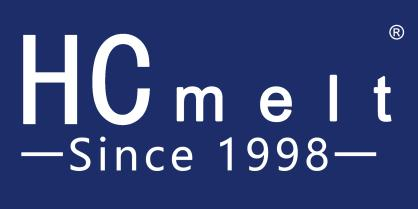

Hot melt adhesive plays a crucial role in modern carton sealing, offering a fast, clean, and cost-effective bonding solution for packaging lines across industries. It is a thermoplastic adhesive that becomes fluid when heated and solidifies quickly upon cooling, creating a strong, reliable seal that holds cartons firmly during shipping and storage.
Hot melt adhesive is made from a blend of polymers, resins, and waxes that determine its bonding strength, viscosity, and heat resistance. When heated to temperatures between 160°C and 190°C, it transforms into a liquid that can be easily applied by a glue gun, roller, or automated machine nozzle. Once the molten adhesive is spread along the carton flaps, it quickly cools and solidifies, forming a durable bond within seconds. This rapid setting characteristic makes it ideal for high-speed production lines in food, beverage, electronics, and logistics packaging.
When used for carton sealing, hot melt adhesive undergoes a three-stage process: heating, application, and bonding. During the heating phase, solid glue pellets or blocks are melted inside a hot melt tank. In the application phase, the liquid adhesive is applied in narrow beads or strips onto carton flaps. Finally, as the carton flaps are pressed together, the adhesive cools down and solidifies, forming a strong mechanical bond.
The strength of this bond depends on factors such as surface energy, adhesive temperature, and open time. Proper temperature control ensures consistent flow and adhesion, while adequate compression time guarantees optimal bonding strength. In automated packaging lines, modern hot melt systems can adjust flow rate and temperature in real time, minimizing waste and maintaining consistent sealing quality.
hot melt adhesives offer several distinct advantages over traditional water-based or solvent-based glues:
| Advantage | Description |
|---|---|
| Fast Setting | The adhesive cools and solidifies within seconds, increasing packaging efficiency and reducing cycle times. |
| Clean Operation | hot melt adhesives leave minimal residue and require no drying time, keeping packaging areas clean. |
| Excellent Bond Strength | Provides strong adhesion to coated and uncoated cardboard surfaces, ensuring reliable carton closure. |
| Temperature Resistance | Maintains bond integrity under a wide range of storage and transport conditions. |
| Cost Efficiency | Reduces glue consumption and waste through precise dispensing, lowering overall packaging costs. |
| Recyclability | Compatible with paper recycling processes, supporting eco-friendly packaging goals. |
To ensure effective carton sealing, several operational factors must be controlled:
Temperature Stability Maintaining the adhesive within its ideal operating temperature range prevents under- or over-heating, which can affect bonding and viscosity. Automated glue tanks with digital temperature controllers help maintain consistency.
Surface Cleanliness Dust, oil, or moisture on carton surfaces can reduce adhesion strength. Proper carton storage and handling ensure clean bonding surfaces.
Compression Time After applying the adhesive, sufficient compression between flaps is necessary to allow proper wetting and cooling. In high-speed lines, precision timing ensures strong, consistent sealing.
Ambient Environment Humidity and ambient temperature can influence open time and cooling speed. Adjusting adhesive formulation or machine settings helps maintain optimal sealing in different climates.
Compared with pressure-sensitive tapes and water-based glues, hot melt adhesives provide better performance in strength, efficiency, and automation compatibility. Tapes can lose adhesion under temperature changes, while water-based glues need long drying times and are unsuitable for coated cartons. Hot melt adhesives, in contrast, deliver instant bonding and superior durability, making them the preferred choice for high-speed packaging operations.
| Method | Bond Time | Durability | Equipment Cost | Automation Compatibility |
|---|---|---|---|---|
| Hot Melt Adhesive | 1–2 seconds | High | Moderate | Excellent |
| Water-Based Glue | 20–30 seconds | Medium | Low | Limited |
| Pressure-Sensitive Tape | Instant | Low | Low | Moderate |
Hot melt adhesive is widely used in packaging lines for a variety of industries:
Food and Beverage: For sealing corrugated boxes that carry bottles, cans, and cartons, ensuring freshness and security.
E-commerce and Logistics: Provides tamper-evident closure and stability for shipping cartons during long-distance transportation.
Electronics: Used to seal boxes for delicate components, offering vibration-resistant and heat-stable sealing.
Consumer Goods: Suitable for retail packaging with coated cardboard or laminated paper.
Frozen Food and Cold Chain Packaging: Special formulations maintain bonding strength under low temperatures.
Advanced hot melt adhesive systems have evolved to include precision control modules, melt-on-demand technology, and energy-efficient heating systems. These features improve production efficiency, reduce downtime, and ensure consistent glue application. Equipment with automatic nozzle cleaning and low-maintenance designs further enhances reliability, especially in 24-hour production environments.
Regular maintenance of hot melt equipment ensures long-term performance. Operators should inspect hoses, filters, and nozzles for clogging or carbonization. Using high-purity adhesives minimizes residue buildup. Safety precautions, such as thermal gloves and shields, protect workers from burns during operation or maintenance.
For companies seeking dependable and efficient carton sealing adhesives, HUACHUN provides a full range of high-performance hot melt adhesive solutions. HUACHUN products are designed for fast bonding, clean operation, and compatibility with automated packaging equipment. The company’s expertise in polymer formulation and equipment integration ensures reliable results across diverse carton sealing applications.